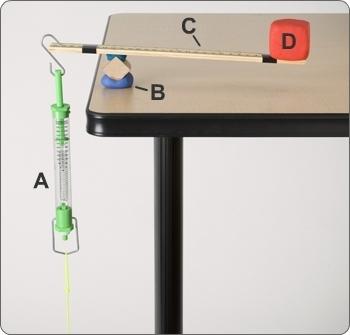
Physics, 30.06.2019 14:00 hdhdhd49jdhd
Refer to the following photo to answer this question. how does the setup shown in the picture affect the mechanical advantage required to lift the clay block? a ruler c is placed on a fulcrum labeled b at the edge of a table. one end of the ruler is balancing a cube labeled d. the other end of the ruler hanging over the edge of the table is holding a spring scale labeled a. question options: the setup decreases the amount of force required to lift the block and, therefore, increases your mechanical advantage. the setup does not change the amount of force required to lift the block. the setup increases the amount of force required to lift the block and, therefore, decreases your mechanical advantage.


Answers: 1


Other questions on the subject: Physics

Physics, 21.06.2019 19:30, sariyamcgregor66321
Molten iron fills a mould, which has a volume of 200 cm cubed. calculate the volume when the iron cools and solidifies. molten iron has a density of 7.0g/cm cubed. in its solid state, iron has a density of 8.0g/cm cubed.
Answers: 3

Physics, 22.06.2019 02:00, LadyHolmes67
The motor m applies a time-varying force of f (200 t) n, where t is in seconds. box b with mass 200 kg starts from rest, and the coefficients of kinetic and static friction are 0.2 and us 0.3 the acceleration due to gravity is g 9.8 m/s2 b 300 a) find the time ' when the box starts to move. b) calculate the speed of the crate at 3 s c) calculate the power delivered by the motor at t 3 s
Answers: 3


Physics, 22.06.2019 10:30, gyexisromero10
Air is to be preheated by hot exhaust gases in a cross-flow heat exchanger before it enters the furnace. air enters the heat exchanger at 95 kpa and 20°c at a rate of 0.6 m^3/s. the combustion gases (cp = 1.10 kj/kg°c) enter at 160°c at a rate of 0.95 kg/s and leave at 95°c. determine the rate of heat transfer to the air and its outlet temperature.
Answers: 2
You know the right answer?
Refer to the following photo to answer this question. how does the setup shown in the picture affect...
Questions in other subjects:


Mathematics, 25.10.2020 21:00

Mathematics, 25.10.2020 21:00

Health, 25.10.2020 21:00



Biology, 25.10.2020 21:00

English, 25.10.2020 21:00

English, 25.10.2020 21:00

History, 25.10.2020 21:00







